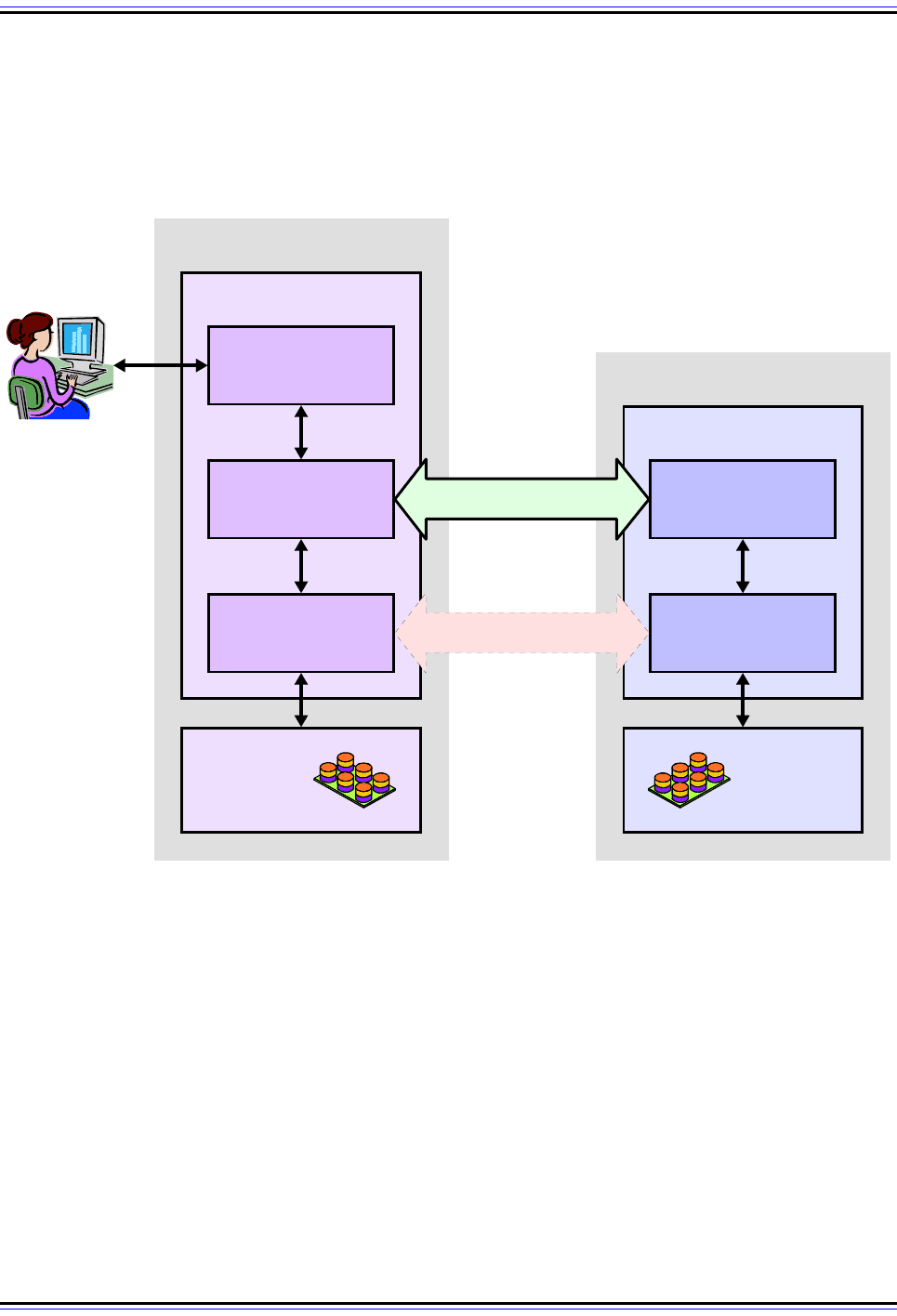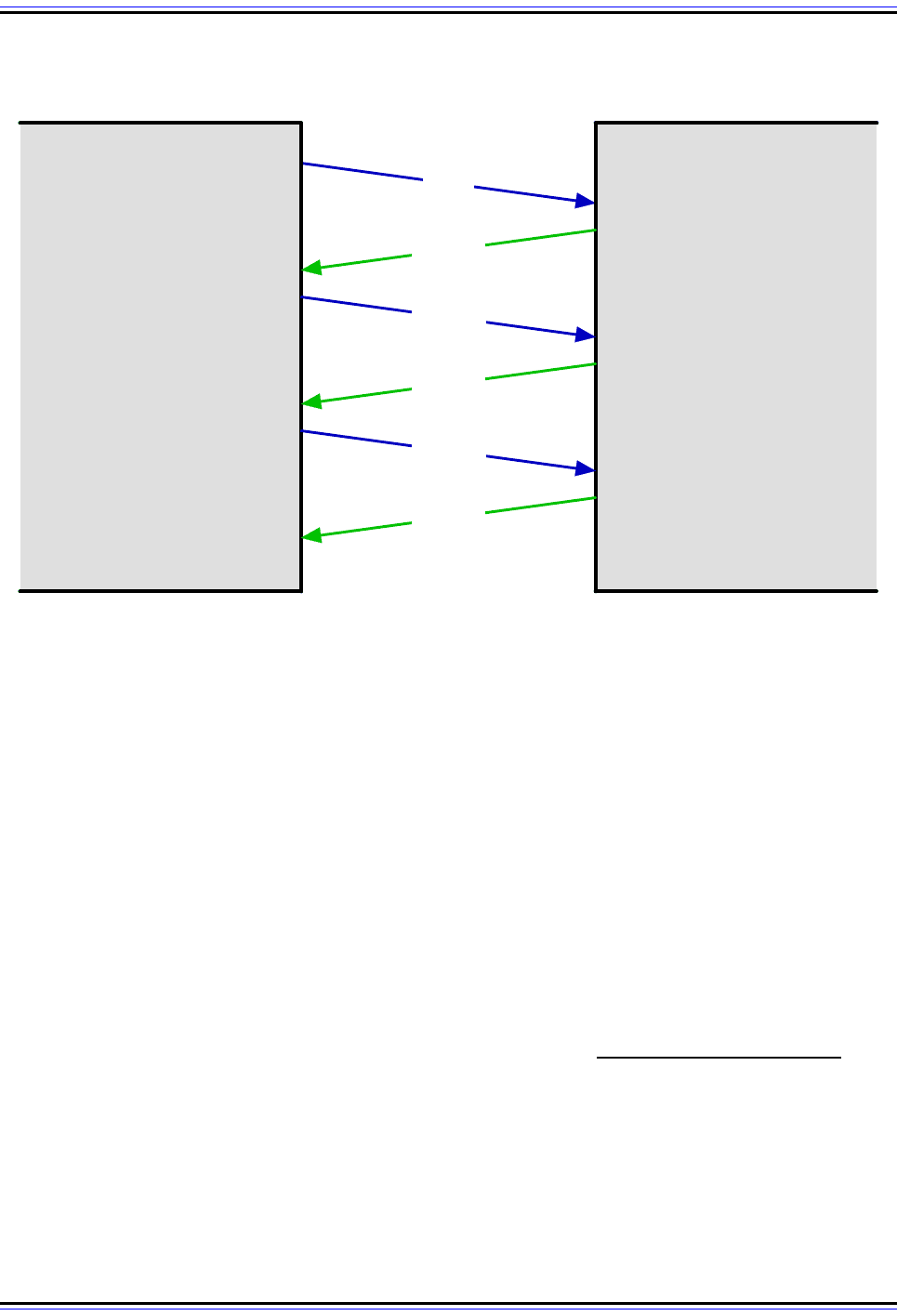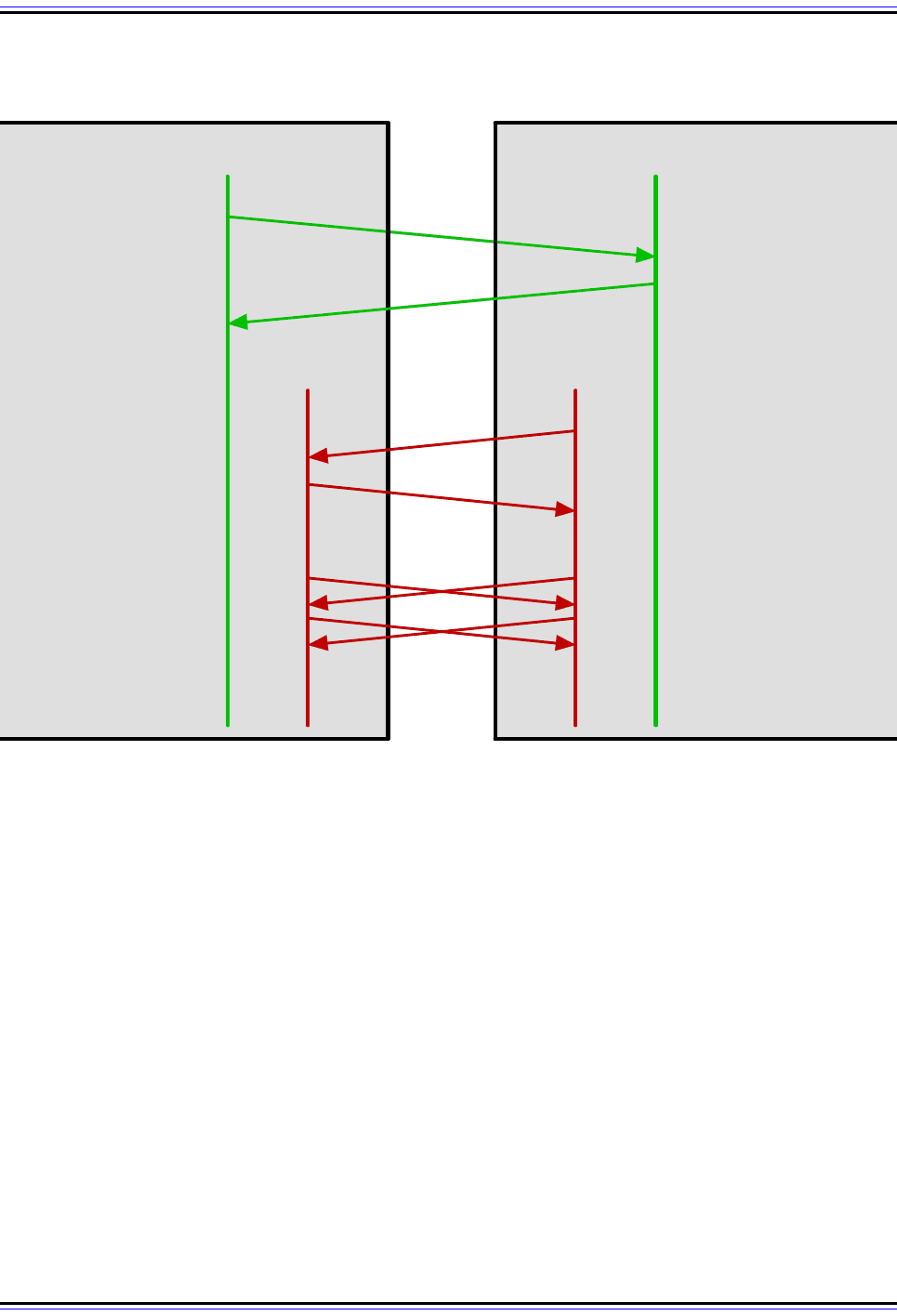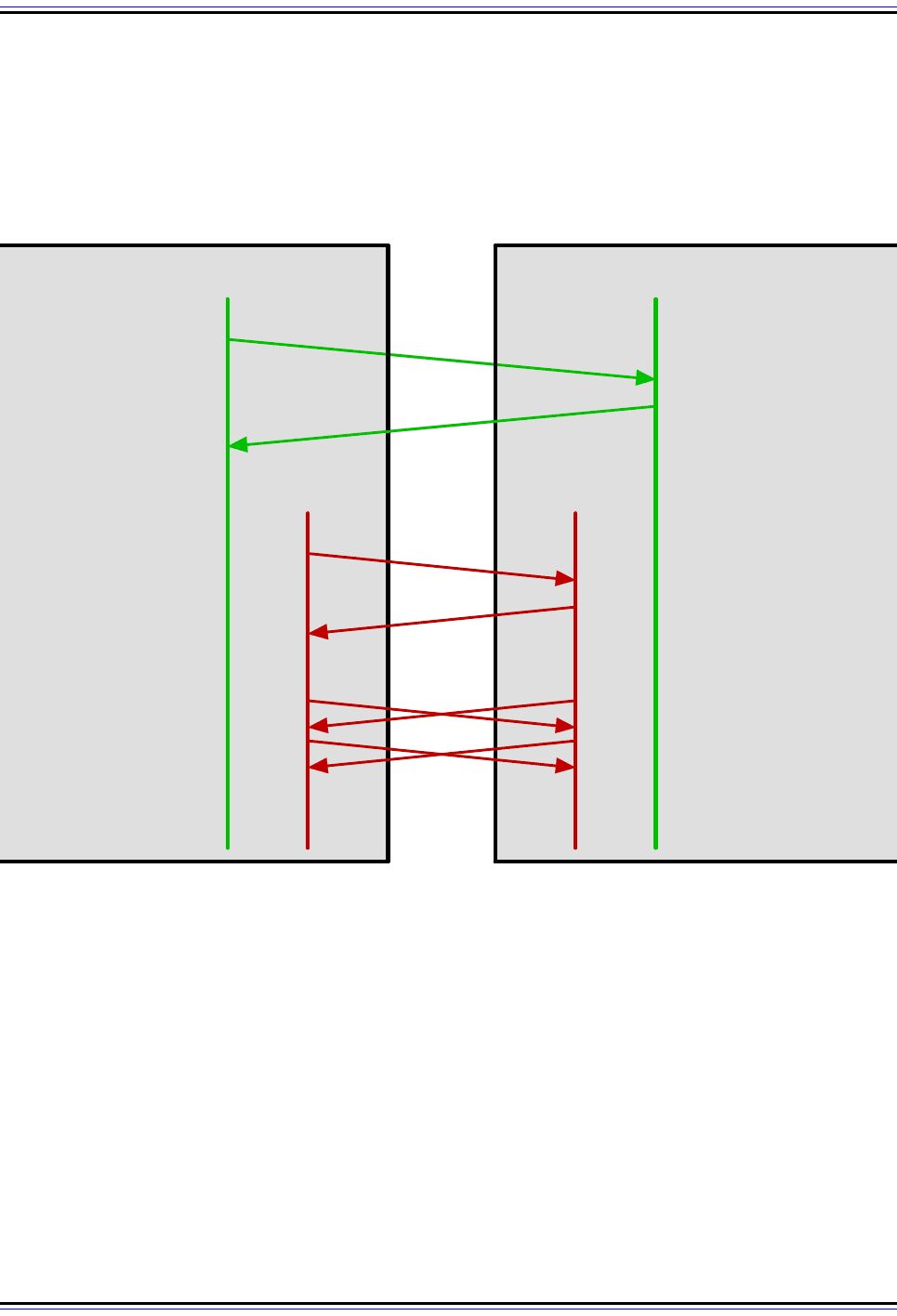Charles M. Kozierok The TCP-IP Guide
Подождите немного. Документ загружается.


The TCP/IP Guide - Version 3.0 (Contents) ` 1321 _ © 2001-2005 Charles M. Kozierok. All Rights Reserved.
Thus, there are two server process components and three client (user) process compo-
nents in FTP. These components are referred to in the FTP model by specific names, which
are used in the standard to describe the detailed operation of the protocol. I plan to do the
same in this section, so I will now describe more fully the components in each device of this
model, which are illustrated in Figure 288.
Server-FTP Process Components
The Server-FTP Process contains these two protocol elements:
☯ Server Protocol Interpreter (Server-PI): The protocol interpreter responsible for
managing the control connection on the server. It listens on the main reserved FTP
port for incoming connection requests from users (clients). Once a connection is
established, it receives commands from the User-PI, sends back replies, and
manages the server data transfer process.
Figure 288: File Transfer Protocol (FTP) Operational Model
FTP is a client/server protocol, with communication taking place between the User-FTP Process on the client
and the Server-FTP Process on the server. Commands, replies and status information are passed between
the User-PI and Server-PI over the control connection, which is established once and maintained for the
session. Data is moved between devices over data connections that are set up for each transfer.
User-FTP Process
User
Interface
FTP Client
User Protocol
Interpreter
(User-PI)
User Data
Transfer Process
(User-DTP)
Client
File System
User
Server-FTP Process
FTP Server
Server Protocol
Interpreter
(Server-PI)
Server Data
Transfer Process
(Server-DTP)
Server
File System
Control Connection
Data Connection

The TCP/IP Guide - Version 3.0 (Contents) ` 1322 _ © 2001-2005 Charles M. Kozierok. All Rights Reserved.
☯ Server Data Transfer Process (Server-DTP): The DTP on the server side, used to
send or receive data to or from the User-DTP. The Server-DTP may either establish a
data connection or listen for a data connection coming from the user. It interacts with
the server's local file system to read and write files.
User-FTP Process Components
The User-FTP Process contains these three protocol elements:
☯ User Protocol Interpreter (User-PI): The protocol interpreter responsible for
managing the control connection on the client. It initiates the FTP session by issuing a
request to the Server-PI. Once a connection is established, it processes commands
received from the user interface, sends them to the Server-PI, and receives back
replies. It also manages the user data transfer process.
☯ User Data Transfer Process (User-DTP): The DTP on the user side, which sends or
receives data to or from the Server-DTP. The User-DTP may either establish a data
connection or listen for a data connection coming from the server. It interacts with the
client device's local file system.
☯ User Interface: The user interface provides a more “friendly” FTP interface to a
human user. It allows simpler user-oriented commands to be used for FTP functions
rather than the somewhat cryptic internal FTP commands, and also allows results and
information to be conveyed back to the person operating the FTP session.
Key Concept: The Server-FTP Process and User-FTP Process both contain a
Protocol Interpreter (PI) element and a Data Transfer Process (DTP) element. The
Server-PI and User-PI are logically linked by the FTP control connection; the Server-
DTP and User-DTP by data connections. The User-FTP Process includes a third
component, the User Interface, which provides the means for the human user to issue
commands and see responses from the FTP software.
Third-Party File Transfer (Proxy FTP)
The FTP standard actually defines a separate model for an alternative way of using the
protocol. In this technique, a user on one host performs a file transfer from one server to
another. This is done by opening two control connections: one each from the User-PI on the
user's machine to the two Server-PI's on the two servers. Then, a Server-DTP is invoked on
each server to send data; the User-DTP is not used.
This method, sometimes called third-party file transfer or proxy FTP, is not widely used
today. A major reason for this is that it raises security concerns, and has been exploited in
the past. Thus, while I felt it was worth mentioning, I will not be discussing it further in my
coverage of FTP.

The TCP/IP Guide - Version 3.0 (Contents) ` 1323 _ © 2001-2005 Charles M. Kozierok. All Rights Reserved.
FTP Control Connection Establishment, User Authentication and Anonymous FTP
Access
The FTP operational model describes the distinct logical data and control channels that are
established between an FTP client (user) and an FTP server. Before the data connection
can be used to send actual files, the control connection must be established. A specific
process is followed to set up this connection and thereby create the permanent FTP
session between devices that can be used for transferring files.
As with other client/server protocols, the FTP server assumes a passive role in the control
connection process. The server protocol interpreter (Server-PI) “listens” on the special well-
known TCP port reserved for FTP control connections: port 21. The User-PI initiates the
connection by opening a TCP connection from the user device to the server on this port. It
uses an ephemeral port number as its source port in the TCP connection.
Once TCP has been set up, the control connection between the devices is established,
allowing commands to be sent from the User-PI to the Server-PI, and reply codes to be sent
back in response. The first order of business after the channel is operating is user authenti-
cation, which the FTP standard calls the login sequence. There are two purposes for this
process:
☯ Access Control: The authentication process allows access to the server to be
restricted to only authorized users. It also lets the server control what types of access
each user has.
☯ Resource Selection: By identifying the user making the connection, the FTP server
can make decisions about what resources to make available to the user.
FTP Login Sequence and Authentication
FTP’s regular authentication scheme is quite rudimentary: it is a simple “username /
password” login scheme, shown in Figure 289. Most of us are familiar with this type of
authentication for various types of access, on the Internet and elsewhere. First, the user is
identified by sending a user name from the User-PI to the Server-PI using the USER
command. Then, the user's password is sent using the PASS command.
The server checks the user name and password against its user database, to verify that the
connecting user has valid authority to access the server. If the information is valid, the
server sends back a greeting to the client to indicate that the session is opened. If the user
improperly authenticates (by specifying an incorrect user name or password), the server will
request that the user attempt authorization again. After a number of invalid authorization
tries, the server may time out and terminate the connection.
Assuming that the authentication succeeds, the server then sets up the connection to allow
the type of access to which the user is authorized. Some users may have access to only
certain files or certain types of files. Some servers may allow particular users to read and
write files on the server, while other users may only retrieve files. The administrator can
thus tailor FTP access as needed.

The TCP/IP Guide - Version 3.0 (Contents) ` 1324 _ © 2001-2005 Charles M. Kozierok. All Rights Reserved.
Once the connection is established, the server can also make resource selection decisions
based on the user's identity. For example, on a system with multiple users, the adminis-
trator can set up FTP so that when any user connects, he or she automatically is taken to
his or her own “home directory”. The optional ACCT (account) command also allows a user
to select a particular account if he or she has more than one.
FTP Security Extensions
Like most older protocols, the simple login scheme used by FTP is a legacy of the relatively
“closed” nature of the early Internet. It is not considered secure by today's global Internet
standards, because the user name and password are sent across the control connection in
clear text. This makes it relatively easy for login information to be intercepted by interme-
diate systems and accounts to be compromised. RFC 2228, FTP Security Extensions
,
defines more sophisticated authentication and encryption options for those who need
added security in their FTP software.
Figure 289: FTP Connection Establishment and User Authentication
An FTP session begins with the establishment of a TCP connection between the client and server. The client
hen sends the user name and password to authenticate with the server. Assuming that the information is
accepted by the server, it sends a greeting reply to the client and the session is open.
FTP ServerFTP Client
(TCP)
1. Establish TCP
Connection To Server
2. Establish TCP Connection,
Send 220 "Ready" Reply
4. Receive User Name, Send
331 "Need Password" Reply
3. Receive "Ready" Reply,
Send User Name
220
USER
5. Receive "Need Password"
Reply, Send Password
6. Receive Password, Send
230 "Greeting" Reply
7. Receive "Greeting"
Reply, Connection Open
331
PASS
230

The TCP/IP Guide - Version 3.0 (Contents) ` 1325 _ © 2001-2005 Charles M. Kozierok. All Rights Reserved.
Key Concept: An FTP session begins with the establishment of a control connection
between an FTP client and server. After the TCP connection be made, the user must
authenticate with the server, using a simple user/password exchange between client
and server. This provides only rudimentary security, so if more is required, it must be imple-
mented using FTP security extensions or through other means.
Anonymous FTP
Perhaps surprisingly, however, many organizations did not see the need for this enhanced
level of security. They in fact went in the opposite direction: using FTP without any authenti-
cation at all. This may seem surprising; why would anyone want to allow just anybody to
access their FTP server? The answer is pretty simple, however: anyone who wants to use
the server to provide information to the general public.
Today, most organizations use the World Wide Web to distribute documents, software and
other files to customers and others who want to obtain them. But in the 1980s, before the
Web became popular, FTP was the way that this was often done. For example, today, if you
have a 3Com network interface card and want a driver for it, you would go to the Web
server www.3com.com, but several years ago, you might have accessed the 3Com FTP
server (ftp.3com.com) to download a driver for it.
Clearly, requiring every customer to have a user name and password on such a server
would be ridiculous. For this reason, RFC 1635 in 1994 defined a use for the protocol called
anonymous FTP. In this technique, a client connects to a server and provides a default user
name to log in as a guest. Usually the names “anonymous” or “ftp” are supported. Seeing
this name, the server responds back with a special message, saying something like “Guest
login ok, send your complete e-mail address as password.”. The password in this case isn't
really a password, of course, it is just used to allow the server to log who is accessing it.
The guest is then able to access the site, though the server will usually severely restrict the
access rights of guests on the system. Many FTP servers support both identified and
anonymous access, with authorized users having more permissions (such as being able to
traverse the full directory path, and having the right to delete or rename files) while
anonymous ones may only be able to read files from a particular directory set up for public
access.
Key Concept: Many FTP servers support anonymous FTP, which allows a guest
who has no account on the server to have limited access to server resources. This is
often used by organizations that wish to make files available to the public for
purposes such as technical support, customer support, or distribution.

The TCP/IP Guide - Version 3.0 (Contents) ` 1326 _ © 2001-2005 Charles M. Kozierok. All Rights Reserved.
FTP Data Connection Management, Normal (Active) and Passive Data Connections
and Port Usage
The control channel created between the Server-PI and the User-PI using the FTP
connection establishment and authentication process is maintained throughout the FTP
session. Commands and replies are exchanged between the protocol interpreters over this
channel, but not data.
Each time files or other data need to be sent between the server and user FTP processes,
a data connection must be created. The data connection links the User-DTP with the
Server-DTP. This connection is required both for explicit file transfer actions (getting or
receiving a file) and also for implicit data transfers, such as requesting a list of files from a
directory on the server.
The FTP standard specifies two different ways of creating a data connection, though it
doesn't really explain them in a way that is very easy to understand. That's my job. The two
methods differ primarily in which device, the client or the server, initiates the connection.
This may at first seem like a trivial matter, but as we'll see shortly, it is actually quite
important.
Normal (Active) Data Connections
The first method is sometimes called creating a normal data connection (because it is the
default method) and sometimes an active data connection (to contrast it to the passive
method we will see in a moment). In this type of connection, the Server-DTP initiates the
data channel by opening a TCP connection to the User-DTP. The server uses the special
reserved port number 20 (one less than the well-known control FTP port number, 21) for the
data connection. On the client machine, the default port number used is the same as the
ephemeral port number used for the control connection, but as we’ll see shortly, the client
will often choose a different port for each transfer.
Let's take an example to see how this works. Suppose the User-PI established a control
connection from its ephemeral port number 1678 to the server's FTP control port of 21.
Then, to create a data connection for data transfer, the Server-PI would instruct the Server-
DTP to initiate a TCP connection from the server's port 20 to the client's port 1678. The
client would acknowledge this and then data could be transferred (in either direction —
remember that TCP is bidirectional).
In practice, having the client’s control and data connection on the same port is not a good
idea; it complicates the operation of FTP and can lead to some tricky problems. For this
reason, it is strongly recommended that the client specify a different port number using the
PORT command prior to the data transfer. For example, suppose the client specifies port
1742 using PORT. The Server-DTP would then create a connection from its port 20 to the
client's port 1742 instead of 1678. This process is shown in Figure 290.

The TCP/IP Guide - Version 3.0 (Contents) ` 1327 _ © 2001-2005 Charles M. Kozierok. All Rights Reserved.
Passive Data Connections
The second method is called a passive data connection. The client tells the server to be
“passive”, that is, to accept an incoming data connection initiated by the client. The server
replies back giving the client the server IP address and port number that it should use. The
Server-DTP then listens on this port for an incoming TCP connection from the User-DTP. By
default, the user machine uses the same port number it used for the control connection, as
in the active case. However, here again, the client can choose to use a different port
number for the data connection if necessary (typically an ephemeral port number.)
Let's consider our example again, with the control connection from port 1678 on the client to
port 21 on the server, but this time consider data transfer using a passive connection, as
illustrated in Figure 291. The client would issue the PASV command to tell the server it
wanted to use passive data control. The Server-PI would reply back with a port number for
Figure 290: FTP Active Data Connection
In a conventional, or active, FTP data connection, the server initiates the transfer of data by opening the data
connection to the client. In this case, the client first sends a PORT command to tell the server to use port
1742. The server then opens the data connection from its default port number of 20 to client port 1742. Data is
then exchanged between the devices using these ports. Contrast to Figure 291.
FTP Client FTP Server
2. Receive PORT
Command, Acknowledge
4. Acknowledge Data
Connection
1. Send PORT 1742
Command
Control Connection
(Port 1678)
Data Connection
(Port 1742)
Control Connection
(Port 21)
Data Connection
(Port 20)
3. Open Data Connection
To Client Port 1742
...
(Send/Receive Data) (Send/Receive Data)

The TCP/IP Guide - Version 3.0 (Contents) ` 1328 _ © 2001-2005 Charles M. Kozierok. All Rights Reserved.
the client to use, say port 2223. The Server-PI would then instruct the Server-DTP to listen
on this port 2223. The User-PI would instruct the User-DTP to create a connection from
client port 1742 to server port 2223. The server would acknowledge this and then data
could be sent and received, again in either direction.
Efficiency and Security Issues In Choosing a Connection Method
This leaves one nagging question, of course: who cares? ☺ I already said that in either
case, the data transfer can go in both directions. So what does it matter who initiates the
data connection? Isn't this like arguing over who makes a local telephone call?
The answer is related to the dreaded “S word”: security. The fact that FTP uses more than
one TCP connection can cause problems for the hardware and software that people use to
ensure the security of their systems.
Figure 291: FTP Passive Data Connection
In a passive FTP data connection, the client uses the PASV command to tell the server to wait for the client to
establish the data connection. The server responds, telling the client what port it should use on the server for
the data transmission, in this case port 2223. The client then opens the data connection using that port
number on the server and a client port number of its own choosing, in this case 1742. Contrast to Figure 291.
FTP Client FTP Server
2. Receive PA SV
Command, Tell Client
To Use Port 2223
3. Open Data Connection
To Server Port 2223
1. Send PASV
Command
Control Connection
(Port 1678)
Data Connection
(Port 1742)
Control Connection
(Port 21)
Data Connection
(Port 2223)
4. Acknowledge Data
Connection
...
(Send/Receive Data) (Send/Receive Data)

The TCP/IP Guide - Version 3.0 (Contents) ` 1329 _ © 2001-2005 Charles M. Kozierok. All Rights Reserved.
Consider what is happening in the case of an active data connection as described in the
example above. From the perspective of the client, there's an established control
connection from the client's port 1678 to the server's port 21. But the data connection is
initiated by the server. So the client sees an incoming connection request to port 1678 (or
some other port). Many clients are suspicious about receiving such incoming connections,
since under normal circumstances clients establish connections, they don’t respond to
them. Since incoming TCP connections can potentially be a security risk, many clients are
configured to block them using firewall hardware or software.
Why not just make it so the client always accepts connections to the port number one
above the ephemeral number used for the control connection? The problem here is that
clients often use different port numbers for each transfer by using the PORT command. And
why is this done? Because of the rules of TCP. As I describe in the section on TCP, after a
connection is closed, a period of time must elapse before the port can be used again, to
prevent mixing up consecutive sessions. This would cause delays when sending multiple
files one after the other, so to avoid this, clients usually use different port numbers for each
transfer. This is more efficient, but means a firewall protecting the client would be asked to
accept incoming connections that appear to be going to many unpredictable port numbers.
The use of passive connections largely eliminates this problem. Most firewalls have a lot
more difficulty dealing with incoming connections to odd ports than outgoing connections.
RFC 1579, Firewall-Friendly FTP, discusses this issue in detail. It recommends that clients
use passive data connections by default instead of using normal connections with the
PORT command, to avoid the port-blocking problem.
Of course, passive data connections don't really eliminate the problem, they just push it off
onto servers. These servers now must face the issue of incoming connections to various
ports. Still, it is, generally speaking, easier to deal with security issues on a relatively
smaller number of servers than a large number of clients. FTP servers must be able to
accept passive mode transfers from clients anyway, so the usual approach is to set aside a
block of ports for this purpose, which the server's security provisions allow to accept
incoming connections, while blocking incoming connection requests on other ports.
Note: As an aside, it is that it is a significant violation of the layering principle of
networks to pass IP addresses and port numbers in FTP commands such as
PORT and PASV and the replies to them. This isn’t just a philosophical issue:
applications aren't supposed to deal with port numbers, and this creates issues when
certain lower-layer technologies are used. For example, consider the use of Network
Address Translation, which modifies IP addresses and possibly port numbers. In order to
prevent NAT from “breaking” when FTP is used, special provision must be made to handle
the protocol.

The TCP/IP Guide - Version 3.0 (Contents) ` 1330 _ © 2001-2005 Charles M. Kozierok. All Rights Reserved.
Key Concept: FTP supports two different models for establishing data connections
between the client and server. In normal, or active data connections, the server
initiates the connection when the client requests a transfer, and the client responds;
in a passive data connection, the client tells the server it will initiate the connection, and the
server responds. Since TCP is bidirectional, data can flow either way in both cases; the
chief difference between the two modes has to do with security. In particular, passive mode
is often used because many client devices today are not able to accept incoming connec-
tions from servers.
FTP General Data Communication and Transmission Modes
Once a data connection has been established between the Server-DTP and the User-DTP,
data is sent directly from the client to the server, or the server to the client, depending on
the specific command issued. Since control information is sent using the distinct control
channel, the entire data channel can be used for data communication. (Of course, these
two logical channels are combined at lower layers along with all other TCP and UDP
connections on both devices, so it's not like this represents a performance improvement
over a single channel. Just wanted to make that clear.)
FTP defines three different transmission modes (also called transfer modes) that specify
exactly how data is sent from one device to another over an opened data channel: stream
mode, block mode, and compressed mode.
Stream Mode
In this mode, data is sent simply as a continuous stream of unstructured bytes. The sending
device simply starts pushing data across the TCP data connection to the recipient. No
message format with distinct header fields is used, making this method quite different from
the way many other protocols send information in discrete chunks. It relies strongly on the
data streaming and reliable transport services of TCP. Since there is no header structure,
the end of the file is indicated simply by the sending device closing the data connection
when it is done.
Of the three methods, stream mode is the one that is by far the most widely used in real
FTP implementations. There are likely three reasons for this. First, it is the default and also
the simplest method, so it is the easiest to implement and one that is required for compati-
bility. Second, it is the most general, because it treats all files as simple streams of byte
without paying attention to their content. Third, it is the most efficient method because no
bytes are wasted on “overhead” such as headers.
